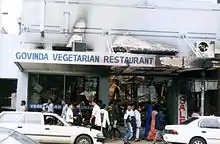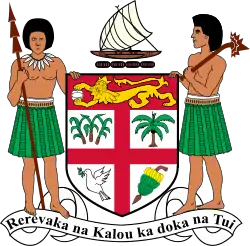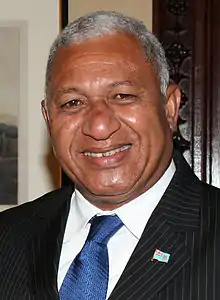2000 Fijian coup d'état
The Fiji coup d'état of 2000 was a civilian coup d'état by hardline i-Taukei (ethnic Fijian) nationalists against the elected government of an Indo-Fijian Prime Minister, Mahendra Chaudhry on 19 May 2000. This was followed by an attempt on 27 May by President Ratu Sir Kamisese Mara to assert executive authority, and then by a military coup on 29 May by Republic of Fiji Military Forces Commander Commodore Frank Bainimarama. The coups resulted in the removal of the elected government and its replacement by an interim regime headed by Josefa Iloilo. In March 2001 the Court of Appeal of Fiji ruled that the coups and interim regime were illegal. An elected government was finally restored by the 2001 Fijian general election.
| 2000 Fijian coup d'état | |||||
|---|---|---|---|---|---|
| Part of the Fiji coups | |||||
 The burnt out remains of Govinda's Restaurant in Suva: over 100 shops and businesses were ransacked in Suva's central business district on 19 May. | |||||
| |||||
| Belligerents | |||||
|
|
Hardline i-Taukei Rebels
| ||||
| Commanders and leaders | |||||
|
|
George Speight Timoci Silatolu Shane Stevens | ||||
| Strength | |||||
| Unknown | Unknown | ||||
| Casualties and losses | |||||
| 4 killed in the Queen Elizabeth Barracks Mutiny | 4 killed in the aftermath of the Queen Elizabeth Barracks Mutiny | ||||
| Hundreds of properties ransacked. | |||||
 |
|---|
| History of Fiji |
|---|
 |
| Early history |
| Modern history |
| Coup of 2000 |
| Proposed Reconciliation Commission |
| Crisis of 2005–2006 |
| Coup of 2006 |
| ||
|---|---|---|
|
Incumbent Timeline
General elections
|
||
Background
The 1999 Fijian general election saw a resounding victory for the People's Coalition, a multiracial grouping of the Fiji Labour Party, Fijian Association Party, National Unity Party and Christian Democratic Alliance.[1] The coalition won 54 of 71 seats, while the Soqosoqo ni Vakavulewa ni Taukei of Sitiveni Rabuka (who had come to power in the 1987 Fijian coups d'état) was reduced to 8 seats.[1] Mahendra Chaudhry became the country's first Indo-Fijian Prime Minister.[2]
Chaudhry's election angered hardline i-Taukei nationalists, as did his government's moves to renew agricultural leases and compensate farmers whose leases had expired. In September 1999 the Great Council of Chiefs rejected the government's plan to renew leases.[3]: 66 Later that month, meetings were held around the country seeking the removal of the government, and former PANU leader Apisai Tora threatened to topple the government through protest marches and civil disobedience.[3]: 66–67 A series of protest marches followed in April 2000, and a large march led by Iliesa Duvuloco was scheduled by 19 May.[3]: 69–70
Seizure of Parliament
On 19 May 2000, the first anniversary of Chaudhry's election, a group of armed men led by failed businessman George Speight stormed the Fijian Parliament and took the government hostage.[4][5][6] The coup was backed by Fiji's Counter Revolutionary Warfare Unit, who provided soldiers and weapons.[3]: 76–77 [7][8]: 223 Speight claimed to have seized power on behalf of ethnic Fijians, and purported to have revoked the 1997 constitution and appointed himself interim president and opposition MP Timoci Silatolu as interim Prime Minister.[6][9] In the immediate aftermath of the takeover, participants in the protest march moved from Government House to surround parliament, while mobs of youths burned and looted Indo-Fijian-owned shops in Suva.[3]: 85 [5]
President Kamisese Mara responded by declaring a state of emergency and police imposed a curfew.[9][10] Former Prime Minister Rabuka initially acted as a negotiator attempting to free the hostages,[3]: 86 [11] but was later dismissed after Speight decided he could no longer trust him.[12] On 20 May ten hostages were released after resigning from the government.[12][13] In a televised press conference Speight swore in Jope Seniloli as interim president, and was then sworn in as Prime Minister, with Silatolu as his deputy and Rakuita Vakalalabure as attorney-general.[3]: 95 [14] Chaudhry was beaten after refusing to resign.[14][15]
Police and the RFMF failed to control access to parliament, allowing people to come and go freely while negotiations continued.[3]: 112 On 26 May the RFMF finally attempted to establish a cordon, resulting in a confrontation with Speight in the presence of international media.[3]: 126 The same day fifteen soldiers and two military officers defected to the rebels.[16] The next day, 200 rebels confronted soldiers at the cordon, resulting in gunfire and two soldiers and a camera operator being wounded.[17][18] The next day President Mara sacked Chaudhry for being unable to perform his functions and appointed Tevita Momoedonu, the sole cabinet member who was not in parliament when it was seized, as Prime Minister.[15] After advising Mara to prorogued parliament for six months, Momoedonu resigned, leaving Mara with "unfettered executive authority".[3]: 128–129 [8]: 223
Military coup
On 28 May, following the broadcast of a news segment critical of Speight, a rebel mob attacked the Fiji TV station, killing a police officer.[19][20][21] The breakdown of law and order saw Chief Justice Timoci Tuivaga and other judges advise RFMF commander Frank Bainimarama to take control on the basis of "necessity".[3]: 134–135 After a meeting with Bainimarama and Rabuka, Mara resigned.[3]: 135–136 [8]: 223 Bainimarama then declared martial law, revoked the 1997 constitution, and took control of the country, declaring himself head of state.[22][23]
The Queen Elizabeth Barracks mutiny
A second attempt by hardline elements to seize power took place on 2 November that year, when rebel soldiers mutinied at Suva's Queen Elizabeth Barracks. The mutiny resulted in the death of four loyal soldiers. Four rebels were subsequently beaten to death after the mutiny had been quelled.
Aftermath
On 15 November, the High Court declared that the interim government was illegal. On 1 March 2001, the Court of Appeal confirmed the High Court decision reinstating the constitution.[24] The government accepted the decision.
On 18 February 2002 George Speight pleaded guilty to treason and was sentenced to death.[25][26] The sentence was commuted to life imprisonment the same day by President Ratu Josefa Iloilo.[27] Ten other rebels received sentences of between 18 months and three years for kidnapping.[27] On 20 March 2003 Josefa Nata and Timoci Silatolu were convicted of treason.[28] On 28 June 2003 both were sentenced to life imprisonment.[29]
An estimated 7,500 jobs were lost because of the coup.
References
- "The 1999 Fiji election and the legacy of history" (PDF). Journal of Pacific Studies. 25 (1): 6. 2001.
- "For First Time, Ethnic Indian Will Lead Fiji". New York Times. 20 May 1999. Retrieved 19 February 2022.
- Field, Michael; Baba, Tupeni; Nabobo-Baba, Unaisi (2005). Speight of Violence : Inside Fiji's 2000 coup (PDF). Canberra: Pandanus Books. ISBN 9781740761703. Retrieved 19 February 2022.
- Sheryl Ho (19 May 2000). "GUNMEN SEIZE PRIME MINISTER HOSTAGE IN FIJI COUP BID". Fiji Crisis. Archived from the original on 22 March 2003.
- "Fiji's PM seized in coup". The Guardian. 19 May 2000. Retrieved 19 February 2022.
- "Gunmen Storm Fiji's Parliament, Announce Government Takeover". Los Angeles Times. 19 May 2000. Retrieved 19 February 2022.
- Michael Field (28 May 2010). "Cloud coup coup land". Stuff. Retrieved 20 February 2022.
- Alley, Roderic (2001). "FIJI'S COUPS OF 1987 AND 2000: A COMPARISON" (PDF). Retrieved 20 February 2022.
- "Fiji's leaders held hostage in 'ethnic' coup". Guardian. 20 May 2000. Retrieved 20 February 2022.
- "FIJI:Civil Coup Attempt: Information Bulletin no: 2" (PDF). IFRC. 20 May 2000. Retrieved 20 February 2022.
- "2000: Fiji Parliament stormed in coup". Otago Daily Times. 2 February 2012. Retrieved 20 February 2022.
- Rowena Singh (22 May 2000). "Fiji Coup : Diary of Events". Fiji Crisis. Archived from the original on 22 March 2003.
- "Coup leader says no to Fiji amnesty". Guardian. 22 May 2000. Retrieved 20 February 2022.
- "Coup leader bungles ceremony". BBC. 20 May 2000. Retrieved 20 February 2022.
- "Fiji hostage drama has violent twist". Guardian. 28 May 2000. Retrieved 20 February 2022.
- "Fiji troops defect to coup leader". BBC. 26 May 2000. Retrieved 20 February 2022.
- "CAMERAMAN, TWO SOLDIERS WOUNDED IN GUNFIRE NEAR PARLIAMENT". Fiji Crisis. 27 May 2000. Archived from the original on 24 February 2003.
- "Shots fired in Fiji coup". BBC. 27 May 2000. Retrieved 20 February 2022.
- "Fijian Police Officer Killed During Melee". Los Angeles Times. 29 May 2000. Retrieved 20 February 2022.
- "Policeman dies in attack on Fiji TV". Fiji Crisis. 29 May 2000. Archived from the original on 22 March 2003.
- "Violence escalates as mob runs riot in Fiji". Guardian. 29 May 2000. Retrieved 20 February 2022.
- "Fiji Military Takes Control And Declares Martial Law". New York Times. 30 May 2000. Retrieved 20 February 2022.
- "Three new decrees revoke Fiji's Constitution". Fiji Crisis. 30 May 2000. Archived from the original on 22 March 2003.
- "High Court upholds ruling on illegality of Fiji Government". New Zealand Herald. 1 March 2001. Retrieved 20 February 2022.
- "Speight sentenced to death". New Zealand Herald. 18 February 2002. Retrieved 20 February 2022.
- "Fiji coup leader sentenced to die". The Guardian. 18 February 2002. Retrieved 20 February 2022.
- "Jail for Fiji rebels". BBC. 19 February 2002. Retrieved 20 February 2022.
- "Fiji coup accomplices found guilty of treason". RNZ. 21 March 2003. Retrieved 20 February 2022.
- "Life sentences for Fiji treason convicts". RNZ. 28 June 2003. Retrieved 20 February 2022.
